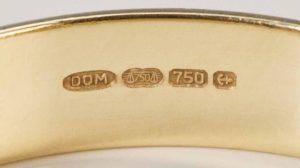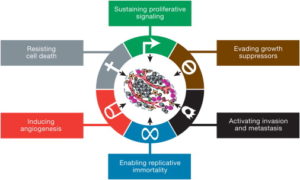Talking with Brandon Berry over the weekend, the subject of aging “Hallmarks” came up. I’m not a fan of this terminology, whether it’s applied to aging, cancer or any other biological condition. Surely there’s got to be something more appropriate?
What does “hallmark” mean?
The etymology of “Hallmark” imbues a very specific meaning – uniqueness. In Ye Olden Days, crafts-persons would set up a Guild, a sort-of business association to protect their products and services. The Guild would sometimes be housed in a Guild Hall (an important building in the town, often sharing premises with the town hall or council offices). The Guild Hall would allow members of the Guild to use the Hall Mark – a unique stamp – to mark their wares, so that buyers could be assured of authenticity.
(img from gold.org)
In theory, using a hallmark ALONE made it possible to tell if what you’re looking at is the real deal. Is this a real 24-karat gold ring made by a master jeweler, or a cheap knock-off? The sole purpose of the hallmark is authentication.
Why “hallmark” should not apply to biology
In biology, long ago someone decided that “hallmark” means “common characteristic”, which is a completely different meaning. Now, instead of a hallmark being a unique identifier (like a fingerprint), it’s just a characteristic found a lot of the time (like blond hair). The problem is NONE of the so-called “hallmarks” of aging or cancer are unique to those conditions. They can all be found in other conditions that are not aging or cancer.
Look at aging…

(from 10.1016/j.cell.2013.05.039)
Mitochondrial dysfunction? Everywhere! Epigenetic Alterations? All over the place. Altered cell communication? Heard them on Spotify last week. None of these things are unique to aging, and frequently lots of them are found together in situations that are not aging.
What about cancer…

(from 10.1016/j.cell.2011.02.013)
Resisting cell death? Hello drugs. Inducing angiogenesis? Meet hypoxia. Evading growth suppression… that’ll be development. Even taking hallmarks into a more specific field such as metabolism doesn’t solve the problem, as many of the phenomena (e.g., the Warburg effect) are found across various other biological states. The problem is with the term hallmarks itself.
So what’s a better term?
I’ll concede that the more hallmarks one finds in a given condition, the more likely it is you can label the condition as bona fide aging or cancer. In-fact, one could even say it is ONLY possible to label something as aging or cancer if ALL of the hallmarks are present (and this conveniently ignores that we may not have identified all the hallmarks yet).
Hmm… everything has to be there for it to be complete. You know what that sounds like? HORCRUXES!
For the uninitiated, in the Harry Potter novels, horcruxes are physical objects used to store a person’s soul. The dark wizard Voldemort disperses his soul across 6 horcruxes plus his body, so the only way to kill him is to destroy all 7.
If the definition of aging or cancer ABSOLUTELY requires a complete complement of hallmarks, they’re not hallmarks. They’re horcruxes. To destroy the thing (aging, cancer etc), you have to fix/destroy all the horcruxes.
I would argue that horcrux is a more appropriate term than hallmark when applied to definitions of biological states. It acknowledges that multiple such entities are required to meet the definition of the disease. It allows for a condition in which horcruxes can be present in other settings that are unrelated (e.g. Harry Potter didn’t realize until near the end that he himself was being used as a horcrux by Voldemort). It also acknowledges (as in the case of HP) that part of the problem is just figuring out what the horcruxes are, and we’re a long way off from being able to say we’ve found all of them. My personal opinion is that it sounds better… “stabbing the 7 horcruxes of aging with a basilisk fang!” And finally, it acknowledges a certain degree of magical thinking has to occur, to believe any complex biological process can be distilled into a half dozen simple things.
Coda
I don’t know quite how the decision was made to wholesale change the definition of hallmark from “unique identifier” to “commonly found characteristic”, but my favorite conspiracy theory is the drafters of the original papers were big fans of the Hallmark TV channel 😉
